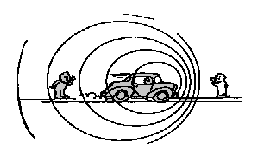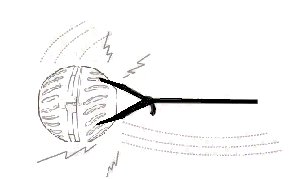AstroCappella: Doppler Shifting

Here It Comes, There It Goes!
An activity by Kara C. Granger
Activity Summary:
Every student can demonstrate the Doppler effect! During this interactive outdoor
procedure, students will use an ordinary toy to reveal the Doppler effect. The
connection is also made to moving cars, and to the shifting of the lines in the
absorption or emission spectrum when the distance between a star and Earth is
increasing or decreasing.
Activity Summary:
Every student can demonstrate the Doppler effect! During this interactive outdoor procedure, students will use an ordinary toy to reveal the Doppler effect. The connection is also made to moving cars, and to the shifting of the lines in the absorption or emission spectrum when the distance between a star and Earth is increasing or decreasing.
Objective:
Students will perform an experiment in which they will demonstrate the Doppler effect. They will also understand the connection to everyday-life examples.
Materials for each group of students:
- 'splash out' ball**
- electronic noise making mechanism with pure tone (from Radio Shack,
or other electronics store)
- 9 volt battery
- 9 volt battery clip
- jump rope
- masking tape
Procedure:
1. Twist the 'splash out' ball open.2. Thread one end of the jump rope through the holes of the 'splash out' ball and tie the end back to the rope. Next, twist the wires of the electronic noise making mechanism together with the wires of the battery clip. Plug the battery into the battery clip, and tape this assembly to the inside of the 'splash out' ball. You now have a 'Doppler ball assembly'. See the illustration below.

3. The teacher should stand about 5 meters away from the students twirling the Doppler ball assembly in a circle above his or her head. In order to gain enough speed, let out about 1.5 meters of jump rope as you twirl it.
4. Students should observe, record and describe what they hear as the Doppler ball approaches, passes, and goes away from them.
5. Let different students try twirling the Doppler ball. Ask them to descibe what they hear.
Discussion:
This is a demonstration of a phenomenon called the Doppler effect. It results from the motion of a source coming towards, and going away from an observer. This effect can occur with both sound and light, because both sound and light reveal wave- like behavior. For instance, if a source of light was a moving star relative to an observer on Earth, this would cause the star's spectra to be shifted toward the red (going away) or toward the blue (coming towards) end of the spectra.The number of waves reaching an observer in one second is called the frequency. For a given speed, frequency depends upon the length of the wave. Long waves have a lower frequency than short waves. As long as the distance between the source of the waves and the observer remains constant, the frequency remains constant. However, if the distance between the observer and the source is increasing, the frequency will decrease. If the distance is decreasing, the frequency will increase. The images below illustrate this effect.

Now imagine an everyday-life example such as observing and listening to an approaching car. The sound waves coming from the engine are squeezed closer together than they would be if the car were still. This happens because the car is moving in your direction. This squeezing of the waves increases the number of waves (i.e., the frequency) that reach your ear every second. But after the noise of the car's engine passes, the frequency diminishes. In actuality, the sound waves are stretched apart by the car's movement in the opposite direction. As the observer, you perceive these frequency changes as changes in the pitch of the sound. The sound's pitch is higher as the car approaches, and lower as it travels away. An image contained in this activity plan, located below the title of this activity, illustrates what happens.
A similar situation takes place with stars. If the distance between a star and Earth is increasing, the lines in the absorption or emission spectrum will shift slightly to the lower frequency, or red end of the spectrum. If the distance is decreasing, the lines will shift toward the blue end. The image below shows a simplified star spectrum with red and blue shifting. Notice how the entire spectra gets shifted to the blue (left) or red (right).

Extensions or Further Discussion:
1. Does the person swinging the Doppler ball assembly hear the Doppler shift? Why or why not?2. Can the red/blue shift technique be used for objects other than stars? Can you tell which way an emergency vehicle is traveling by the pitch of its siren?
3. What has the Doppler shift told astronomers about the expansion of the universe?
Reference:
The general idea for this lesson plan was adapted from a Doppler effect lesson located within 'Space-Based Astronomy: A Teacher's Guide with Activities' associated with the Office of Space Science Astrophysics division of NASA.Thank you to John Wood for suggesting the use of the Doppler ball assembly.
**This toy is made by Galoob and can be bought at your local toy store. For more information, contact Galoob Customer Service at 1-800-442-5662.
